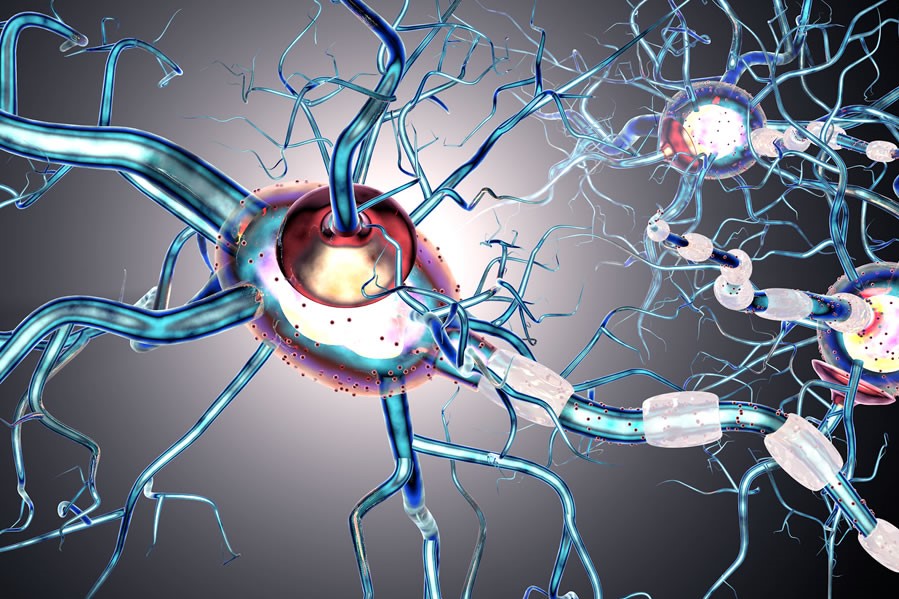
Multiple sclerosis, what it is, symptoms, diagnosis and treatment
Multiple sclerosis is a demyelinating neurodegenerative disease, i.e. one with lesions in the central nervous system
In multiple sclerosis, damage and loss of myelin occurs in several areas (hence the name ‘multiple’) of the central nervous system
Numerous clinical and experimental evidences indicate that the basis of MS is a reaction of the immune system that triggers an inflammatory process that affects circumscribed areas of the central nervous system and causes the destruction of myelin and the specialised cells, the oligodendrocytes, that produce it.
These areas of myelin loss (or ‘demyelination’), also known as ‘plaques’, can be scattered anywhere in the cerebral hemispheres, with a predilection for the optic nerves, cerebellum and spinal cord.
Underlying MS is therefore a process of demyelination that leads to damage or loss of myelin and the formation of lesions (plaques) that can evolve from an initial inflammatory phase to a chronic phase, in which they take on scar-like characteristics, hence the term ‘sclerosis’.
There are approximately 2.5-3 million people with MS worldwide, of whom 600,000 in Europe and over 118,000 in Italy.
The distribution of the disease is not uniform: it is more common in areas far from the equator with a temperate climate, particularly Northern Europe, the United States, New Zealand and South Australia.
MS can begin at any age of life, but is mostly diagnosed between the ages of 20 and 40 and in women, who are affected in twice the number of men.
Multiple Sclerosis, in terms of frequency, is the second most frequent neurological disease in young adults and the first chronic inflammatory disease
The causes of the disease are still partly unknown, however scientific evidence indicates that the disease originates from a combination of environmental and genetic factors.
MS classification
- Clinically isolated syndrome (CIS)
- Relapsing-remitting multiple sclerosis (RRMS)
- Secondarily progressive multiple sclerosis (SM-SP)
- Primary progressive multiple sclerosis (MS-PP)
- Radiologically isolated syndrome (RIS)
People with multiple sclerosis have different symptoms based on the different possible localisation of lesions in the central nervous system
Most symptoms due to MS can be successfully addressed and treated through specific pharmacological and non-pharmacological therapies (rehabilitation).
There are approximately 2.5-3 million people affected worldwide, of whom 600,000 in Europe and over 118,000 in Italy.
MOST COMMON SYMPTOMS are: fatigue, sensitivity disorders, visual disorders, pain, sexual disorders, spasticity, bladder disorders, intestinal disorders, cognitive disorders, depression, coordination disorders (ataxia, tremor), speech disorders (dysarthria), paroxysmal disorders.
LESS COMMON SYMPTOMS occur less frequently than the common symptoms and are: swallowing disorders, headache, hearing loss, epilepsy, respiratory problems.
Diagnosis of Multiple Sclerosis
The diagnosis is made by the doctor on the basis of these basic elements:
- The symptoms
- The neurological examination
- Instrumental investigations (MRI brain+rachis in toto without and with mdc)
- Evoked potentials
- Lumbar puncture
- Blood tests
Therapy
ATTACK THERAPY (POUSSIS) – Corticosteroids
LONG-TERM THERAPIES-DMT, disease-modifying treatments, preventing relapses or delaying disease progression (e.g. INTERFERONE)
SYMPTOMATIC THERAPIES-Therapies that combat symptoms (anxiety, insomnia, depression, fatigue, neuropathic pain, erectile dysfunction, urinary disorders, spasticity, postural tremor, etc.).
Read Also
Emergency Live Even More…Live: Download The New Free App Of Your Newspaper For IOS And Android
Multiple Sclerosis: What Are The Symptoms Of MS?
Rehabilitation Therapies In The Treatment Of Systemic Sclerosis
ALS Could Be Stopped, Thanks To The #Icebucketchallenge
Relapsing-Remitting Multiple Sclerosis (RRMS) In Children, EU Approves Teriflunomide
ALS: New Genes Responsible For Amyotrophic Lateral Sclerosis Identified
What Is “Locked-In Syndrome” (LiS)?
Amyotrophic Lateral Sclerosis (ALS): Symptoms To Recognise The Disease


